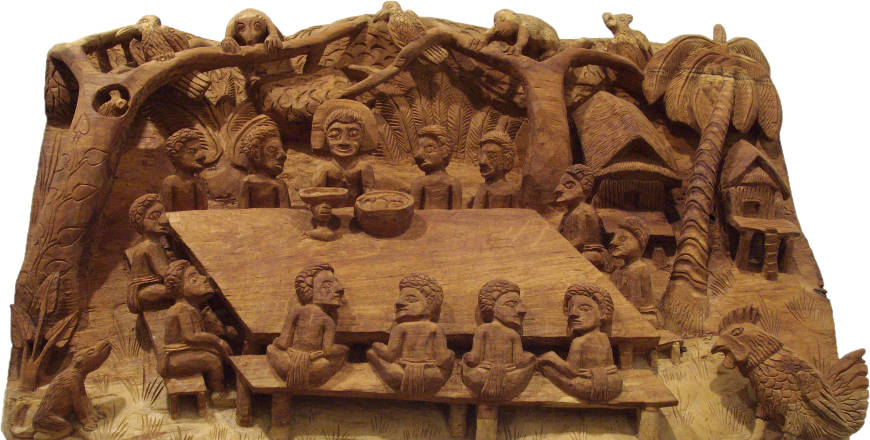Rarities, mysteries, culturally significant pieces and items of high monetary value are among an LCA collection of ‘extraordinary’ artefacts, which will be relaunched in a new home with a new name in June. The artefacts, predominantly from Papua New Guinea (PNG), which had been housed in the Louise Flierl Mission Museum at Hahndorf in the […]
Rarities, mysteries, culturally significant pieces and items of high monetary value are among an LCA collection of ‘extraordinary’ artefacts, which will be relaunched in a new home with a new name in June.
The artefacts, predominantly from Papua New Guinea (PNG), which had been housed in the Louise Flierl Mission Museum at Hahndorf in the Adelaide Hills since 1998, have been relocated to the LLL building at 175 Archer Street, North Adelaide. The Hahndorf building, which was owned by St Paul’s Lutheran Church, has been sold, necessitating the move.
Wantok Place, as the museum will be known, will be open to the public from 16 June 2019. It will carry the subtitle ‘Museum of Papua New Guinea Artefacts’. Timothy Pietsch, the project manager for the museum relocation, says the new name honours PNG culture through the use of the Pidgin word ‘wantok’ (translating to ‘one-talk’ in English), which means friend, partner, or a speaker of the same language. ‘The word catches the idea of partnership, of working together, of people who share the same values’, Mr Pietsch said.
Pastor Richard Haar, a former missionary in PNG, says ‘wantoks’ are people ‘who belong together, who are friends and compatriots [in the Kingdom of God]’.
‘It is precisely this partnership in the gospel that the museum’s name seeks to capture and celebrate’, he says. ‘Our common connection is … a unity in the gospel that transcends race, culture and distance and directly leads into mission. The museum acknowledges how the LCA has been blessed by mission work in PNG.’
The majority of its approximately 1500 artefacts were given to or acquired by Australian Lutheran missionaries and lay people who worked in PNG missions from 1886 for the next 100 years. The artefacts were donated to the museum.
Some 50 of the artefacts come from the LCA’s South-East Asia mission partners in Malaysia, Singapore, Indonesia and Thailand. Most of these items have been given to the LCA by Australian Lutheran College scholarship holders.
Wantok Place will display approximately 1000 pieces. These include daggers, bows, arrows, shields, spears, sorcery and magic bundles, bullroarers, flutes, masks, tools, jewellery, pots, drums, conch shells, bilums (woven bags) and storyboards.
Mr Pietsch says the new premises in the eastern wing of the LLL building is ‘an ideal home for a museum, with good security, climate and lighting control’. The new layout is designed along geographical mission regions and will feature new interpretive signage.
The museum’s Committee of Management will oversee and advise on its operation to the LCA’s Committee for International Mission. Wantok Place will likely be staffed by volunteers under a part-time manager.
The museum will be open to the general public, including school and church groups and individuals, and may include a small shop selling tourist-quality items from the collection to help finance museum operations. The museum committee will also seek financial benefactors or friends of the museum to help with ongoing funding.
Mr Pietsch says the re-launch of the collection is ‘an exciting new development for LCA International Mission, and an opportunity to publicise to the LCA/NZ and the public the wonderful work that has gone on, and continues to go on, in our overseas mission partner fields’.
‘We have some extraordinary artefacts in the museum – some are extremely rare; some are culturally and financially very significant’, he says. ‘There are some mysteries as well – we don’t know their provenance or donor [see ‘Can you help solve this mystery‘].
‘In re-establishing the museum, we have worked with experts from South Australian Museum, History Trust of South Australia, Artlab, Lutheran Archives, and others. These people have expressed surprise and pleasure at the beauty and cultural significance of this collection.’
Pastor Matt Anker, LCA Assistant to the Bishop – International Mission, says some of the most fascinating items in the collection are also ‘the most controversial’. ‘As people came to confess Jesus as Lord, they often gave the missionaries items connected with the spiritual or magical rites which had ruled their lives before they heard the gospel’, he says. ‘While we might be tempted to say such things have no place in a Christian museum, they are a wonderful reminder of how the gospel freed our Melanesian brothers and sisters from fear.’
Committee members Rev Dr Dean Zweck and Mrs Dorothy Zweck say the collection at Wantok Place is important to them for three reasons: ‘It preserves aspects of culture and mission in PNG and beyond, which would otherwise become lost or forgotten; it shows that Lutheran missionaries respected and admired the people and their cultural traditions; and it is a visible sign of our ongoing partnership and friendship with partner churches in PNG and South-East Asia.’
Reprinted with kind permission of The Lutheran. Visit the website to find out more about The Lutheran or to subscribe.
The museum is open Wednesdays from 10.00am to 4.00pm. Bookings for Wantok Place can be made for group visits, by emailing wantok-place@lca.org.au or by phoning the museum manager, Timothy Pietsch, on 08 8267 7410. Visit the website for more information at www.lca.org.au/wantok-place


0 Comment